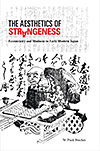book
The Aesthetics of Strangeness: Eccentricity and Madness in Early Modern Japan
by W. Puck Brecher :: University of Hawai‘i Press :: Reviewed by Larry Clark ’94

Eccentricity and odd artistic behavior in the Edo period of Japan (1600–1868) proliferated as an aesthetic subculture that both resisted the rigidity of the Tokugawa realm and served as a source of moral and cultural values.
This study by Brecher, an assistant professor of Japanese language at Washington State University, delves into the complex role of oddballs and eccentrics as sources of artistic innovation and eventually as an influence on Japanese society.
Consider the story of Striped Kanjuro. A “harmless oddball” immortalized in the annals of strangeness from the Edo period, his home was painted entirely in stripes, he only wore striped clothing, and he even cut his food into stripes. But rather than being just a deviant, Brecher points out that Kanjuro’s idiosyncrasies fit with important writers and artists of the time as they became part of the mental landscape of Japanese society.
For example, the poet Basho’s penchant for wandering the land, embrace of eccentricity, and his manipulation of poetic forms altered the course of Japanese poetry. Basho and others also aligned themselves with an older Chinese and Daoist tradition of artistic madness, which often held that eccentrics were virtuous moral paragons.
However, Basho, saké-fuelled artist Beisanjin, print artist Hokusai, and other eccentrics of the period stood counter to the orthodoxy that the ruling Tokugawa shogunate wished to impose on all aspects of society, including the arts. That conflict offers a chance to explore early modern Japan’s culture through those artists and writers.
“Viewing the Edo period through the lens of strangeness ... highlights tensions between artistic correctness and strangeness, as well as the intellectual discourse surrounding those tensions,” writes Brecher. Late Tokugawa society realized, “the full aesthetic potentials of eccentric art as well as its transformative contributions to mainstream Japanese culture.”
Although this book discusses eccentric artists in a particular Japanese historical and cultural context, Brecher’s exploration offers some fascinating insight into art and strange artists for readers beyond specialists in Japanese studies.